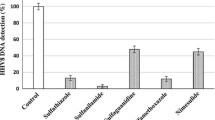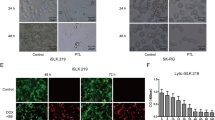Abstract
Kaposi’s sarcoma-associated herpesvirus (KSHV) has been linked to Kaposi’s sarcoma primary effusion lymphoma (PEL), and multicentric Castleman’s disease. Intentional lytic induction of gammaherpesviruses in the presence of antiviral drugs is thought to be an effective treatment option for gammaherpesvirus-related tumors. In this study, we used a cell-based fluorescence bioassay system in which a KSHV-infected PEL cell line was stably transfected with a potent viral-promoter-driven reporter gene to identify effective non-toxic reagents capable of inducing latent KSHV. Among 400 plant extracts screened, three extracts increased reporter gene expression in a dose-dependent manner. Furthermore, the three extracts activated the RTA promoter and induced expression of lytic genes in the endogenous viral genomes of KSHV-infected tumor cells. Together, our results demonstrate the effectiveness of a moderate-throughput screening system to identify natural products capable of inducing KSHV reactivation, thereby facilitating the development of novel therapeutic agents for KSHV-associated malignancies.




Similar content being viewed by others
References
Ameri A (1998) The effects of Aconitum alkaloids on the central nervous system. Prog Neurobiol 56:211–235
An WG, Hwang SG, Trepel JB, Blagosklonny MV (2000) Protease inhibitor-induced apoptosis: accumulation of wt p53, p21WAF1/CIP1, and induction of apoptosis are independent markers of proteasome inhibition. Leukemia 14:1276–1283
Aoki Y, Tosato G (2004) Therapeutic options for human herpesvirus-8/Kaposi’s sarcoma-associated herpesvirus-related disorders. Expert Rev Anti Infect Ther 2:213–225
Boulanger E, Gerard L, Gabarre J, Molina JM, Rapp C, Abino JF, Cadranel J, Chevret S, Oksenhendler E (2005) Prognostic factors and outcome of human herpesvirus 8-associated primary effusion lymphoma in patients with AIDS. J Clin Oncol 23:4372–4380
Brown HJ, McBride WH, Zack JA, Sun R (2005) Prostratin and bortezomib are novel inducers of latent Kaposi’s sarcoma-associated herpesvirus. Antivir Ther 10:745–751
Butler MS (2004) The role of natural product chemistry in drug discovery. J Nat Prod 67:2141–2153
Casper C, Wald A (2007) The use of antiviral drugs in the prevention and treatment of Kaposi sarcoma, multicentric Castleman disease and primary effusion lymphoma. Curr Top Microbiol Immunol 312:289–307
Cesarman E, Chang Y, Moore PS, Said JW, Knowles DM (1995) Kaposi’s sarcoma-associated herpesvirus-like DNA sequences in AIDS-related body-cavity-based lymphomas. N Engl J Med 332:1186–1191
Chang Y, Cesarman E, Pessin MS, Lee F, Culpepper J, Knowles DM, Moore PS (1994) Identification of herpesvirus-like DNA sequences in AIDS-associated Kaposi’s sarcoma. Science 266:1865–1869
Cragg GM, Newman DJ, Snader KM (1997) Natural products in drug discovery and development. J Nat Prod 60:52–60
Deng H, Young A, Sun R (2000) Auto-activation of the RTA gene of human herpesvirus-8/Kaposi’s sarcoma-associated herpesvirus. J Gen Virol 81(Pt 12):3043–3048
Deng H, Liang Y, Sun R (2007) Regulation of KSHV lytic gene expression. Curr Top Microbiol Immunol 312:157–183
Eltom MA, Jemal A, Mbulaiteye SM, Devesa SS, Biggar RJ (2002) Trends in Kaposi’s sarcoma and non-Hodgkin’s lymphoma incidence in the United States from 1973 through 1998. J Natl Cancer Inst 94:1204–1210
Feng WH, Israel B, Raab-Traub N, Busson P, Kenney SC (2002) Chemotherapy induces lytic EBV replication and confers ganciclovir susceptibility to EBV-positive epithelial cell tumors. Cancer Res 62:1920–1926
Feng WH, Hong G, Delecluse HJ, Kenney SC (2004) Lytic induction therapy for Epstein-Barr virus-positive B-cell lymphomas. J Virol 78:1893–1902
Feng WH, Kenney SC (2006) Valproic acid enhances the efficacy of chemotherapy in EBV-positive tumors by increasing lytic viral gene expression. Cancer Res 66:8762–8769
Fu DX, Tanhehco YC, Chen J, Foss CA, Fox JJ, Lemas V, Chong JM, Ambinder RF, Pomper MG (2007) Virus-associated tumor imaging by induction of viral gene expression. Clin Cancer Res 13:1453–1458
Gradoville L, Gerlach J, Grogan E, Shedd D, Nikiforow S, Metroka C, Miller G (2000) Kaposi’s sarcoma-associated herpesvirus open reading frame 50/RTA protein activates the entire viral lytic cycle in the HH-B2 primary effusion lymphoma cell line. J Virol 74:6207–6212
Inoue N, Winter J, Lal RB, Offermann MK, Koyano S (2003) Characterization of entry mechanisms of human herpesvirus 8 by using an RTA-dependent reporter cell line. J Virol 77:8147–8152
Jiang S, Song MJ, Shin EC, Lee MO, Kim SJ, Park JH (1999) Apoptosis in human hepatoma cell lines by chemotherapeutic drugs via Fas-dependent and Fas-independent pathways. Hepatology 29:101–110
Klass CM, Krug LT, Pozharskaya VP, Offermann MK (2005) The targeting of primary effusion lymphoma cells for apoptosis by inducing lytic replication of human herpesvirus 8 while blocking virus production. Blood 105:4028–4034
Koehn FE, Carter GT (2005) The evolving role of natural products in drug discovery. Nat Rev Drug Discov 4:206–220
Li X, Zhao X, Fang Y, Jiang X, Duong T, Fan C, Huang CC, Kain SR (1998) Generation of destabilized green fluorescent protein as a transcription reporter. J Biol Chem 273:34970–34975
Lukac DM, Kirshner JR, Ganem D (1999) Transcriptional activation by the product of open reading frame 50 of Kaposi’s sarcoma-associated herpesvirus is required for lytic viral reactivation in B cells. J Virol 73:9348–9361
Newman DJ, Cragg GM (2007) Natural products as sources of new drugs over the last 25 years. J Nat Prod 70:461–477
Parravicini C, Chandran B, Corbellino M, Berti E, Paulli M, Moore PS, Chang Y (2000) Differential viral protein expression in Kaposi’s sarcoma-associated herpesvirus-infected diseases: Kaposi’s sarcoma, primary effusion lymphoma, and multicentric Castleman’s disease. Am J Pathol 156:743–749
Shaw RN, Arbiser JL, Offermann MK (2000) Valproic acid induces human herpesvirus 8 lytic gene expression in BCBL-1 cells. Aids 14:899–902
Song MJ, Brown HJ, Wu TT, Sun R (2001) Transcription activation of polyadenylated nuclear RNA by RTA in human herpesvirus 8/Kaposi’s sarcoma-associated herpesvirus. J Virol 75:3129–3140
Song MJ, Li X, Brown HJ, Sun R (2002) Characterization of interactions between RTA and the promoter of polyadenylated nuclear RNA in Kaposi’s sarcoma-associated herpesvirus/human herpesvirus 8. J Virol 76:5000–5013
Soulier J, Grollet L, Oksenhendler E, Cacoub P, Cazals-Hatem D, Babinet P, d’Agay MF, Clauvel JP, Raphael M, Degos L et al (1995) Kaposi’s sarcoma-associated herpesvirus-like DNA sequences in multicentric Castleman’s disease. Blood 86:1276–1280
Staskus KA, Zhong W, Gebhard K, Herndier B, Wang H, Renne R, Beneke J, Pudney J, Anderson DJ, Ganem D, Haase AT (1997) Kaposi’s sarcoma-associated herpesvirus gene expression in endothelial (spindle) tumor cells. J Virol 71:715–719
Staudt MR, Dittmer DP (2007) The RTA/Orf50 transactivator proteins of the gamma-herpesviridae. Curr Top Microbiol Immunol 312:71–100
Sun R, Lin SF, Gradoville L, Yuan Y, Zhu F, Miller G (1998) A viral gene that activates lytic cycle expression of Kaposi’s sarcoma-associated herpesvirus. Proc Natl Acad Sci USA 95:10866–10871
Sunwoo JB, Chen Z, Dong G, Yeh N, Crowl Bancroft C, Sausville E, Adams J, Elliott P, Van Waes C (2001) Novel proteasome inhibitor PS-341 inhibits activation of nuclear factor-kappa B, cell survival, tumor growth, and angiogenesis in squamous cell carcinoma. Clin Cancer Res 7:1419–1428
Vieira J, O’Hearn PM (2004) Use of the red fluorescent protein as a marker of Kaposi’s sarcoma-associated herpesvirus lytic gene expression. Virology 325:225–240
Whitby D, Marshall VA, Bagni RK, Miley WJ, McCloud TG, Hines-Boykin R, Goedert JJ, Conde BA, Nagashima K, Mikovits J, Dittmer DP, Newman DJ (2007) Reactivation of Kaposi’s sarcoma-associated herpesvirus by natural products from Kaposi’s sarcoma endemic regions. Int J Cancer 120:321–328
Yoo SM, Zhou FC, Ye FC, Pan HY, Gao SJ (2005) Early and sustained expression of latent and host modulating genes in coordinated transcriptional program of KSHV productive primary infection of human primary endothelial cells. Virology 343:47–64
Yu F, Harada JN, Brown HJ, Deng H, Song MJ, Wu TT, Kato-Stankiewicz J, Nelson CG, Vieira J, Tamanoi F, Chanda SK, Sun R (2007) Systematic identification of cellular signals reactivating Kaposi sarcoma-associated herpesvirus. PLoS Pathog 3:e44
Acknowledgments
The authors would like to thank Dr. Yunkyun Kim (Dankuk University, Korea) for calculating the EC50 values and Ms. Nahyun Kim (Korea University) for measuring phorbol ester levels in the natural products. This work was supported by grants to M.J.S. from the Korean Ministry of Education and Human Resources Development (2006).
Author information
Authors and Affiliations
Corresponding author
Rights and permissions
About this article
Cite this article
Cho, HJ., Yu, F., Sun, R. et al. Lytic induction of Kaposi’s sarcoma-associated herpesvirus in primary effusion lymphoma cells with natural products identified by a cell-based fluorescence moderate-throughput screening. Arch Virol 153, 1517–1525 (2008). https://doi.org/10.1007/s00705-008-0144-4
Received:
Accepted:
Published:
Issue Date:
DOI: https://doi.org/10.1007/s00705-008-0144-4




